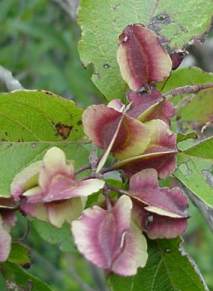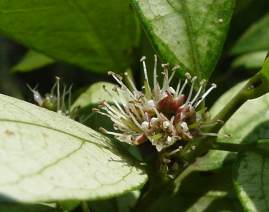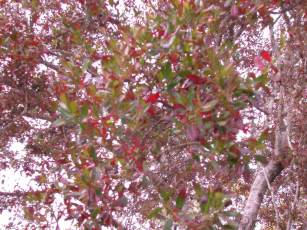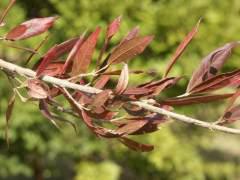Combretum kraussii
Combretum kraussii Hochst.
Family: Combretaceae
Common names: forest bushwillow (Eng.), bosvaderlandswilg (Afr.), uhwabhu, umdubu-wehlathi (Zulu), ulandile (Xhosa), imbondvo-lemhlophe, umdvubu (Swazi), modlubu (Northern Sotho), muvuvhu, muvuvhu-wannda, muvuvhu-wa-thavhani (Venda)
SA Tree No: 540
Introduction
Handsome, quick growing and reasonably cold resistant, this tree is recommended for shady areas in gardens with a mild to warm climate.

Description
Description
This is a medium to large tree, that has been classified as mostly evergreen (Carr 1988) or deciduous or semi-deciduous (Van Wyk & Van Wyk 1997) tree. This beautifully decorative tree's leaves turn bright red to purple in winter, dropping just before flowering, which starts around August and continues through to November.
The flowers are creamy-white and carried in dense heads. Some trees also have a showy flush of small white leaves in spring which either turn green (Palmer & Pitman 1972) or are replaced by the bright green leaves (Coates Palgrave 2002). Four-winged fruit carried in clusters from about February to June follow the flowers. The fruit are small, light to dark red and turn a conspicuous brownish red when dry.

Conservation Status
Status
According to the Red List of South African Plants, Combretum kraussii is not threatened and is classified as Least Concern (LC).
Distribution and habitat
Distribution description
Found from the coast to the midlands in the eastern regions of South Africa and neighbouring Swaziland. The habitat ranges from rocky hillsides at altitudes from almost sea level up to 1 200 m. It grows anywhere from evergreen forest or forest margins to dense woodland.

Derivation of name and historical aspects
History
The specific name of this tree honours Dr F. Krauss of the Stuttgart Museum who made a collecting trip to South Africa in 1837-1840.
Ecology
Ecology
Combretums are pollinated by various kinds of insects, including bees. They have adapted to wind dispersal by developing a wing-like fruit structure that can carry the seed with the help of air currents or wind. Some animals are known to eat Combretum fruit and also help with the seed dispersal.
Uses
Use
The young stems are pliable and used in basket-making. The wood is tough and yellowish in colour; the sawdust can however cause a skin irritation. Certain parts from the tree are used to produce antidiuretics, lotions for eye infections, as well as antiseptics.

Growing Combretum kraussii
Grow
Its range of seasonal features make this a good choice for the garden. In spring it bears white flowers and an unusual flush of white leaves, the red fruits of late summer are showy and in winter its leaves turn fiery before falling. Combretum kraussii grows easily and quickly from seed. Fruit can be harvested, since it is produced in fair quantities and is usually not unduly parasitized. If fruit is collected for cultivation purposes it should be checked for parasites. Indications of parasites being present are small circular holes in the body or a gummy excrescence. Fruit should be stored in a dry place. It is a good idea to take the seed out of the fruit covering and soak it for an hour or so before sowing. Sow the seeds at a depth of 3-5 mm below the surface in a well-drained medium. The first seedling appears 9 to17 days after sowing. All seeds should have germinated after 15 to 29 days.
Protect seedlings from too much moisture - check that the soil drains well. Shelter seedlings from severe heat and cold for at least the first year. This is a fast-growing tree and can reach 1.7 m after two summers.
This tree is reasonably drought resistant. Water seedlings every 3-4 days in summer and every 7-10 days in winter.
For more about possible pests please see Combretum microphyllum.
References
- Carr, J.D. 1988. Combretaceae in southern Africa. Tree Society of Southern Africa, Johannesburg.
- Coates Palgrave, M. 2002. Keith Coates Palgrave Trees of southern Africa, edn 3. Struik, Cape Town.
- Palmer, E. & Pitman, N. 1972. Trees of southern Africa, vol. 3. Balkema, Cape Town.
- Van Wyk, B. & Gericke, N. 2000. People's plants. Briza Publications, Pretoria.
- Van Wyk, B., Van Oudtshoorn, B. & Gericke, N. 1997. Medicinal plants of South Africa. Briza Publications, Pretoria.
- Van Wyk, B. & Van Wyk, P. 1997. Field guide to trees of southern Africa. Struik, Cape Town.
Credits
Lou-Nita Le Roux
Lowveld National Botanical Garden
July 2003
With additions by Yvonne Reynolds
Plant Attributes:
Plant Type: Tree
SA Distribution: Eastern Cape, KwaZulu-Natal, Limpopo, Mpumalanga
Soil type: Sandy, Loam
Flowering season: Spring, Early Summer
PH: Neutral
Flower colour: White, Cream
Aspect: Full Sun, Morning Sun (Semi Shade), Afternoon Sun (Semi Shade)
Gardening skill: Easy
Special Features:
Horticultural zones









Rate this article
Article well written and informative
Rate this plant
Is this an interesting plant?
Login to add your Comment
Back to topNot registered yet? Click here to register.